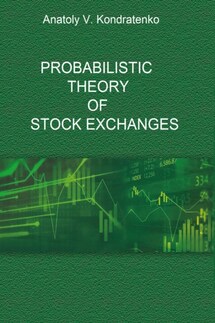Probabilistic Theory of Stock Exchanges - страница 5
To be clear, let us emphasize once again that all currently wide known economic theories, including neoclassical economics as the mainstream, are essentially heuristic or, at best, empirical theories built upon observation of the economic activities of market agents and the state, as well as on collecting various economic facts and their subsequent verbal generalization into a set of formulated principles for the economic activities of people and enterprises as well as the economic policies of the state. Not surprisingly, therefore, the theories of finance derived from them are extremely limited in their ability to quantitatively describe the temporal fine structure of the dynamics of ordinary and even more so of organized markets both because of our limited knowledge of the general economic laws governing the functioning of markets and because of an almost complete lack of a mathematical body which could be used to calculate at the microscopic level the temporal fine structure of markets in small time intervals, such as one trade session, and then to discover new patterns of how the markets work, using detailed comparison of the obtained results with the experimental data.
In this book we are committed to consistently overcome the above problems within the framework of probabilistic economics according to the following program of actions: developing a mathematical apparatus for calculating ab initio (from the first principles) the temporal fine structure of organized financial markets or exchanges, determining patterns in the functioning of financial markets obtained by comparing theoretical results with experimental data provided by exchanges, and eventually determining the patterns governing these markets, in the strict mathematical language. The patterns thus obtained can be used to derive motion equations that describe the temporal dynamics of market economic systems, in other words, equations that describe the evolution of economies. Thus, the purpose of this study is to create a theory of organized markets that has a sound experimental foundation. Meanwhile, if this venture proves successful, it could be argued that the previously constructed probabilistic economic theory also received a solid experimental foundation.
Using the analogy with the theory of scattering, we can say that probabilistic economics is aimed at solving the direct problem of economics, namely, based on some general principles, to calculate the results of economic activity or economic experiments and to compare them directly with the corresponding experimental data, which will allow to obtain a reliable interpretation of experimental data. At the same time, econometric studies solve the opposite problem – to extract information about the properties of the studied economic system from the experimental data using the help of mathematical methods. In order to avoid misunderstandings, we emphasize that everything that is stated in this monograph, and everything that is asserted in it, unless specifically stated, concerns only the direct problem of economics.
All of the above can be phrased somewhat differently. At the present time, there are two main problems of economic science in the theory of organized markets.
Problem 1 is the almost complete absence of a mathematical body that would allow us to conduct full-fledged theoretical calculations of the details of the exchange markets temporal dynamics at the microscopic level on a small-time scale, for example within 1 hour or one trading session.







